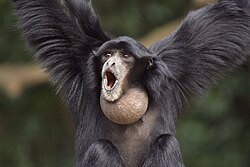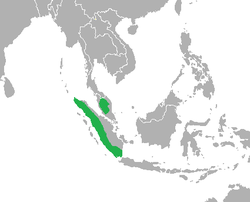Symphalangus syndactylus
| Siamang | |
|---|---|
 |
|
| Siamang at the Chiba Zoo in Japan. | |
| Scientific classification | |
| Kingdom: | Animalia |
| Phylum: | Chordata |
| Class: | Mammalia |
| Order: | Primates |
| Suborder: | Haplorhini |
| Family: | Hylobatidae |
| Genus: |
Symphalangus Gloger, 1841 |
| Species: | S. syndactylus |
| Binomial name | |
|
Symphalangus syndactylus (Raffles, 1821) |
|
 |
|
| Distribution map | |
The siamang (Symphalangus syndactylus) is an arboreal black-furred gibbon native to the forests of Malaysia, Thailand, and Sumatra. The largest of the gibbons, the siamang can be twice the size of other gibbons, reaching 1 m in height, and weighing up to 14 kg. The siamang is the only species in the genus Symphalangus.
The siamang is distinctive for two reasons. The first is that two digits on each foot are partially joined by a membrane—hence the name "syndactylus", from the Ancient Greek sun-, "united" + daktulos, "finger". The second is the large gular sac (found in both males and females of the species), which is a throat pouch that can be inflated to the size of the siamang's head, allowing it to make loud, resonating calls or songs.
Two subspecies of the siamang may exist. If so, they are the nominate Sumatran siamang (S. s. syndactylus) and the Malaysian siamang (S. s. continentis, in peninsular Malaysia). Otherwise, the Malaysian individuals are only a population. The siamang occurs sympatrically with other gibbons; its two ranges are entirely within the combined ranges of the agile gibbon and the lar gibbon.
The siamang can live to around 40 years in captivity.
While the illegal pet trade takes a toll on wild populations, the principal threat to the siamang is habitat loss in both Malaysia and Sumatra. The palm oil production industry is clearing large swaths of forest, reducing the habitat of the siamang, along with that of other species, such as the Sumatran tiger.
The siamang inhabits the forest remnants of Sumatra Island and the Malay Peninsula, and is widely distributed from lowland forest to mountain forest—even rainforest—and can be found at altitudes up to 3800 m. The siamang lives in groups of up to six individuals (four individuals on average) with an average home range of 23 hectares. Their day ranges are substantially smaller than those of sympatric Hylobates species, often less than 1 km. The siamang's melodious singing breaks the forest's silence in the early morning after the agile gibbons' or lar gibbons' calls. The siamang in Sumatra and the Malay Peninsula are similar in appearance, but some behaviors differ between the two populations.
...
Wikipedia

